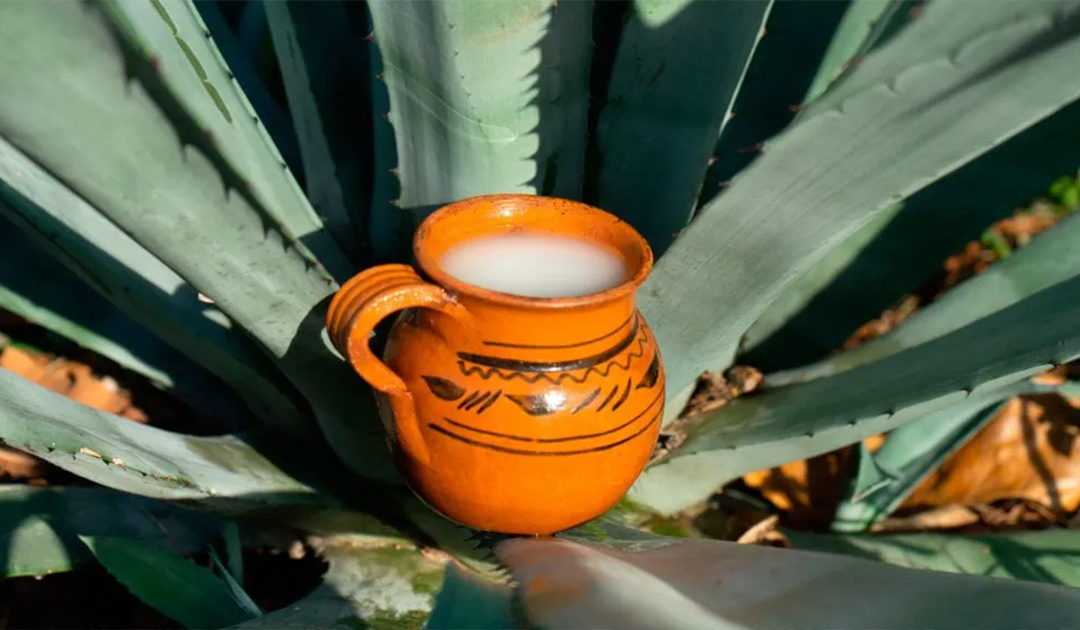“You can sit there and drink pulque for hours and you just don’t get drunk,” said an expert in Mexico’s epicurean delights. “Then you get up to leave and realize your legs don’t really work right. Your mind is completely clear, but your body doesn’t work.”
We know that everyone is more familiar and in love with tequila or the brave ones with mezcal, but pulque is the stuff of legend and the start point of everything else!
On a microscopic scale, pulque is fermented using wild yeasts and not through cultured yeasts in a lab. But before diving into its production techniques, one must understand the significance of pulque’s history and how it factors into Mexican drinking culture today. Though pulque is often historically revered as the beverage of Aztec ritual and deities, the drink predates even the Aztec civilization by millennia.
When did pulque originate?
There is no exact recorded date for when pulque was first consumed, but archaeological evidence suggests the drink may date to at least 2000 B.C. with the Hñähñú (nyaa-nyuu) peoples of central Mexico, also known as the Otomí. Ancient Mayan glyphs featured a fermented agave beverage that was not only imbibed but also represented as being used for enemas. Pulque, along with other fermented beverages of Mexico, is recorded to have been also consumed by other peoples and civilizations in Mexico.
Its name is thought to be derived from the Nahuatl “poliuhqui,” meaning “decomposed.” However, it was also known as “octili” or “wine” to to the Nahuatl- speaking Aztec, “xè” in Ixcateco, “zo” in Zapoteco, and “chih” to the Mayas. This linguistic variance goes to show how vital pulque was, and remains, throughout many communities.
Pulque is reportedly a great source of probiotics, protein, and various vitamins and minerals. In its long and strange life, it’s been used as an aphrodisiac, a fuel for celebrations, and to ease the pain of sacrificial victims. Because it’s so vitamin- and mineral-rich, it was once consumed in arid parts of Mexico when water was scarce, and some pregnant women and new mothers still drink it to promote health and lactation.
There are several Aztec myths relating the origins or early history of the drink. Many of these involve Mayahuel, goddess of the maguey. The sap of the plant was thought to be her blood. Another tale claims that pulque was discovered by possum (yes, the animal), and one Aztec story even traces the drink to their cultural predecessors, the Toltec.
Side note: There is a group of deities in Aztec mythology called the Centzon Totochtin. This translates to “four hundred rabbits,” and that’s exactly what they were, meeting frequently to celebrate their roll as the gods of drunkenness.
How is pulque made?
The frothy white beverage predates the arrival of the Spanish by at least 1,500 years; it’s the ancient ancestor of mezcal and tequila. All three drinks come from the same family of plants, but pulque is made by fermenting – as opposed to distilling – the sap of maguey, or agave.
Four types of maguey plants are used to make pulque: Salmiana, Mapisag, Manso or Noble, and Atrovirens, all of which are endemic to Mexico. Of these four Salmiana is the most well-known and most commonly used.
The maguey plant can take eight to 12 years to reach maturity and produce sap, or “aguamiel” meaning literally honey water. Fermentation starts almost immediately after the plant is cut and the aguamiel begins to run; the beverage continues to ferment – and become more alcoholic – as it makes its way down your throat. It’s usually between 2% and 8% alcohol but tends toward the lower end of the spectrum.
What does pulque taste like?
Pulque must express the aromas of its plant and have a certain freshness and hints of fruit or flowers. It shouldn’t have a funny smell or be slimy and should be lightly viscous, but never the same consistency as drinking nopal cactus juice.
The fresher the pulque, the cleaner, smoother, and more refreshing the taste. As the drink ages and continues to ferment, it becomes thicker, stickier, and can even become stringy, much like those little brown strings found in kombucha. We can’t mince words here: pulque in its purest form can be acidic, sour, and a bit difficult to put back. Thankfully, fermented pulque can be blended with fruit and spices to make the taste a bit more palatable.
Why is different from tequila?
Pulque and tequila are both made from the agave plant, but tequila is made from the Blue Agave plant and pulque is made from the sap of the agave plant. Tequila is clear and has a strong alcoholic content, while pulque is opaque and has a lower alcoholic content. Tequila is typically drunk straight, while pulque is often mixed with other beverages.
Is tequila distilled from pulque?
There is no easy answer to this question as it is somewhat of a contentious topic among experts. Some say that tequila can be distilled from pulque, while others contend that the two are entirely different spirits. It is often called “the mother of tequila” because some believe that tequila was first distilled from pulque. However, others argue that tequila has always been made from the distilled juice of the agave plant, and that pulque is a completely separate beverage. Ultimately, the answer to this question depends on who you ask.
Mexico is a nation between two civilizations and two pasts. It has a very long drinking history and it definitely worths your time to discover it, wheather you try pulque, tequila, mezcal or raicilla. Never stop exploring!

